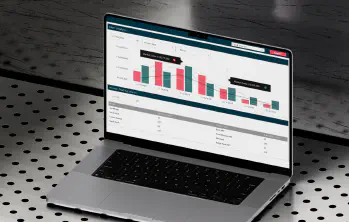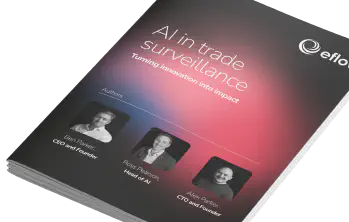Technology Innovations in Regtech: AI, Blockchain, and Automation
AI, blockchain and crypto regulation
This week, we examine how emerging technologies such as artificial intelligence (AI), blockchain, and automation are shaping the future of regulatory technology (Regtech). To provide valuable insights into these developments, we spoke with Jonathan Dixon, Head of Surveillance at eflow. Jonathan is a leader in the Regtech space with over a decade of experience spanning client, vendor, exchange, and consultancy roles. His deep understanding of market surveillance and compliance makes him a key authority on the technological innovations driving the industry forward.
At eflow, Jonathan plays a pivotal role in ensuring that products are continuously refined to meet market demands. He also works closely with clients, conducting market surveillance abuse health checks and helping companies adhere to best practices in compliance. His perspective offers critical insights into how technologies like AI, machine learning, blockchain, and automation are transforming the Regtech landscape and addressing the complexities of modern financial markets.
In this article, we explore Jonathan’s views on key technological advancements, their potential to enhance market integrity, and the future role of Regtech in an increasingly digital and decentralized financial ecosystem.
The impact of cryptocurrencies and blockchain on market integrity
Blockchain technology and the rise of cryptocurrencies have introduced new dynamics to financial markets, creating both opportunities and challenges in maintaining market integrity. According to Jonathan, the rapid growth of digital assets, particularly the emergence of cryptocurrency exchange-traded funds (ETFs), has already started to create demand for more robust Regtech solutions.
“As MiCA comes into effect, as we start moving more into crypto regulation, there will be requirements for firms to engage with. The bigger firms already do it—Coinbase, Kraken, Binance, Bitfinex, Bitstamp—and many others will as well,” Jonathan explains. This highlights how the major players in the cryptocurrency space are adapting to regulatory pressures as governments and financial institutions look to increase oversight.
The introduction of cryptocurrency ETFs represents a significant step in the institutionalisation of digital assets, which in turn raises questions about market integrity and the need for enhanced surveillance mechanisms. “Now there’s big demand for cryptocurrency ETFs. They are going to have to consider market integrity and that’s not just for Bitcoin but also Ethereum, as there’s now an Ethereum ETF,” Jonathan adds, noting the broader regulatory implications as digital assets become a more mainstream component of global markets.
The rise of blockchain-based assets demands sophisticated tools for ensuring transparency and preventing market manipulation. Regtech solutions will need to evolve to address these challenges, offering new levels of oversight that can maintain confidence in rapidly growing digital asset markets.
AI and machine learning’s role in advancing Regtech
Artificial intelligence (AI) and machine learning (ML) are poised to significantly enhance Regtech’s ability to address regulatory compliance and market surveillance challenges. However, Jonathan highlights the complexity of harnessing these technologies effectively. On the one hand, firms are using AI for advanced trading strategies, while on the other hand, the same technology must be utilised to identify and mitigate market abuse.
The implementation of AI in Regtech is multifaceted, and it will require continuous adaptation to counteract the potential misuse of AI in financial markets.
Large language models (LLMs), a subset of AI, are already proving useful in analysing vast amounts of unstructured data, such as emails, chat logs, and communications, to detect intent and identify market abuse. “Large language models have a space in eComms; they have the potential to derive intent from communications across unstructured data,” Jonathan explains.
Machine learning is also increasingly used to refine the surveillance process, reducing false positives by improving the quality of alerts generated by compliance systems. Jonathan points out how AI can enhance risk scoring and parameterisation in Regtech platforms: “Machine learning can be used to help provide risk scores for alerts and also to help with the dynamic parameterisation of models.” This ability to dynamically adjust risk parameters based on historical data and client-specific needs will allow firms to respond more effectively to potential risks.
In essence, AI and machine learning are becoming indispensable in enhancing the efficiency and accuracy of market surveillance, enabling firms to identify high-risk activities quickly while reducing the volume of poor quality false-positive alerts.
Innovations in data analytics to enhance market surveillance
With the ever-increasing volume of market data generated daily, innovations in data analytics are critical to maintaining market surveillance and integrity. Jonathan stresses the importance of utilizing large data sets to uncover patterns and correlations between different instruments and asset classes, which can play a vital role in detecting market manipulation.
“I think this is where it comes back to looking at larger data sets and big data. And that also goes hand-in-hand with cross-product events,” Jonathan explains. The ability to identify correlations between different instruments and markets is essential for a more comprehensive understanding of market behaviour and potential risks.
These innovations in data analytics allow Regtech solutions to delve deeper into the complex relationships between various financial products and markets, enabling firms to spot anomalies that might indicate market abuse. As Jonathan points out, understanding historical trading patterns is key: “We define [market abuse] based on things that have happened before… You have to base it off historical trading patterns.”
The continued development of data analytics tools will empower Regtech platforms to interpret larger datasets more accurately, thereby enhancing the effectiveness of market surveillance across a broader range of asset classes and financial products.
Automation’s role in regulatory compliance and market oversight
Automation is increasingly recognised as a powerful tool for streamlining regulatory compliance processes and enhancing the efficiency of market oversight. However, Jonathan underscores the limitations of relying solely on automated systems for compliance, particularly when it comes to addressing regulatory expectations.
“The scope for dealing with regulatory expectations is limited. And the reason for that is turning around to the regulator and going, ‘We didn’t look at this alert because the AI said so,’ or ‘The automated process said so,’ lacks explainability or accountability” Jonathan warns. While automation can significantly enhance the speed and accuracy of identifying risks, it is critical that firms retain control over decision-making processes and remain accountable to regulators.
Jonathan emphasises that automation should assist in prioritising and filtering risks, allowing firms to focus their resources where they are most needed: “The job of Regtech firms like eflow is to help you get to your risk quicker and understand what’s important and what isn’t. Now we can do that by risk scoring, we can do that by suggesting assessment changes.”
Automation can be used to streamline repetitive tasks, such as generating alerts and managing large data flows. However, Jonathan advises that firms must strike a balance between automated processes and human oversight to ensure the quality and accuracy of decision-making. “If we’re automating that process, I would argue why generate these alerts in the first place. If they’re so low quality that they don’t require human intervention at any level,” he adds, emphasising the importance of refining systems to avoid generating unnecessary alerts.
Jonathan also points out that in many cases, automated processes still require human oversight in the form of quality assurance, making it clear that complete automation is not always the most practical or effective solution. “Even if you generate 10,000 trading alerts and close them all out automatically, you’re still probably going to be obligated to do QA or quality assurance on 10% or 15% of them,” he explains.
While automation can bring efficiency, firms must ensure that they continue to assess risks and maintain control over compliance processes, particularly in sensitive areas like market surveillance.
The future of real-time compliance monitoring
The concept of real-time compliance monitoring has gained considerable attention in recent years, with firms looking for ways to detect and respond to market abuse as it happens. However, Jonathan expresses caution about the practical application of real-time monitoring in most regulatory environments.
“Real time monitoring assumes every analyst is desperately waiting for an alert to come in, which is invariably not the case. Being an analyst for many years, you’re sitting there working on your backlog and high-priority cases,” Jonathan explains. He suggests that while real-time monitoring might be appropriate in certain contexts—such as exchanges that need to act quickly on large moves—it is not necessarily a priority for most firms.
Jonathan acknowledges that real-time monitoring could be valuable for halting trades during significant market moves or identifying manipulation, but he argues that most firms will benefit more from systems that allow for thorough analysis of historical data. “For exchanges, I see a rationale together with the cessation of trade activity and a temporary halt on stocks or assets that might need it, but generally, yeah, I’m a bit sceptical,” he notes.
In his view, unstructured data analysis will continue to be an essential tool for identifying intent and building a holistic picture of market abuse. “There is value in the analysis of unstructured data whereby people are talking about doing things before they’ve done them,” Jonathan says. However, he cautions that detecting intent from communications must be complemented by actual market activity to create a complete view of potential wrongdoing.
Conclusion
As the Regtech industry continues to evolve, technologies like AI, blockchain, data analytics, and automation will play an increasingly important role in enhancing market integrity and regulatory compliance. Jonathan Dixon’s insights underscore the importance of staying at the forefront of technological innovation while maintaining a balance between automation and human oversight.
AI and machine learning offer powerful tools for analysing unstructured data and refining risk parameters, while blockchain and cryptocurrencies present new challenges and opportunities for market surveillance. Automation can streamline compliance processes but must be employed carefully to ensure accountability. The future of Regtech will likely involve a combination of real-time monitoring for certain markets and more comprehensive data analysis to maintain long-term oversight and market transparency.



